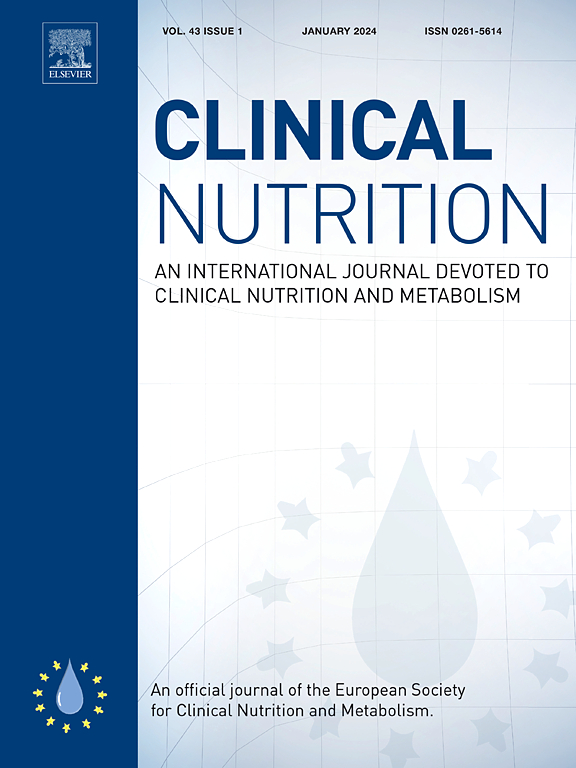Plasma kynurenine pathway metabolites in association with diabetes: A cross-sectional study
IF 7.4
2区 医学
Q1 NUTRITION & DIETETICS
引用次数: 0
Abstract
Background
Abnormalities of the kynurenine pathway of tryptophan catabolism have been linked with an increased risk of cardiovascular disease. However, the association between kynurenine pathway metabolism and diabetes remains unclear.
Methods
We conducted a secondary analysis of the baseline data of 796 adults from the Prospective Follow-up Study on Cardiovascular Morbidity and Mortality in China (PFS-CMMC). Plasma kynurenine pathway metabolites, including tryptophan, kynurenine, kynurenic acid (KA), 3-hydroxykynurenine (3-HK), anthranilic acid (AA), 3-hydroxyanthranilic acid (3-HAA), xanthurenic acid (XA), 2-ketoadipic acid (2-KAA), and nicotinamide, were measured by ultrahigh performance liquid chromatography tandem mass spectrometry. Unconditional logistic regression analyses were used to calculate odds ratios (ORs) and their 95 % confidence intervals (CIs).
Results
After adjustment for all confounders, three metabolites were positively associated with increased odds of diabetes. The OR (95 % CI) for the highest compared with the lowest quartile was 2.07 (1.16, 3.78) for 3-HAA, 3.56 (1.93, 6.83) for 2-KAA, and 1.82 (1.01, 3.35) for nicotinamide (all P trend <0.05). In contrast, participants in the fourth quartile of tryptophan levels had reduced odds of diabetes when compared to those in the first quartile (OR: 0.39, 95 % CI: 0.21, 0.72; P trend = 0.007). No significant associations were observed for plasma kynurenine, KA, 3-HK, AA, or XA.
Conclusions
Increased plasma 3-HAA, 2-KAA, and nicotinamide were associated with higher odds of diabetes, whereas higher levels of tryptophan were associated with lower odds of diabetes in the community-dwelling population. Our findings suggest that the kynurenine pathway metabolites may be involved in the pathophysiology of diabetes.
血浆犬尿氨酸途径代谢物与糖尿病的相关性:一项横断面研究
背景:色氨酸分解代谢的犬尿氨酸途径异常与心血管疾病的风险增加有关。然而,犬尿氨酸途径代谢与糖尿病之间的关系尚不清楚。方法我们对来自中国心血管发病率和死亡率前瞻性随访研究(PFS-CMMC)的796名成年人的基线数据进行了二次分析。采用超高效液相色谱串联质谱法测定血浆中犬尿氨酸途径代谢物,包括色氨酸、犬尿氨酸、犬尿氨酸酸(KA)、3-羟基犬尿氨酸(3-HK)、邻苯甲酸(AA)、3-羟基苯甲酸(3-HAA)、黄嘌呤酸(XA)、2-酮己酸(2-KAA)和烟酰胺。使用无条件逻辑回归分析计算优势比(ORs)及其95%置信区间(ci)。结果在对所有混杂因素进行校正后,三种代谢物与糖尿病发病率增加呈正相关。3-HAA最高与最低四分位数的OR (95% CI)为2.07 (1.16,3.78),2-KAA为3.56(1.93,6.83),烟酰胺为1.82 (1.01,3.35)(P趋势均为0.05)。相比之下,色氨酸水平第四个四分位数的参与者患糖尿病的几率比第一个四分位数的参与者低(OR: 0.39, 95% CI: 0.21, 0.72;P趋势= 0.007)。血浆犬尿氨酸、KA、3-HK、AA或XA无显著相关性。结论:在社区居民中,血浆3-HAA、2-KAA和烟酰胺水平升高与糖尿病发病率升高相关,而色氨酸水平升高与糖尿病发病率降低相关。我们的研究结果提示犬尿氨酸途径代谢产物可能参与糖尿病的病理生理。
本文章由计算机程序翻译,如有差异,请以英文原文为准。
求助全文
约1分钟内获得全文
求助全文
来源期刊

Clinical nutrition
医学-营养学
CiteScore
14.10
自引率
6.30%
发文量
356
审稿时长
28 days
期刊介绍:
Clinical Nutrition, the official journal of ESPEN, The European Society for Clinical Nutrition and Metabolism, is an international journal providing essential scientific information on nutritional and metabolic care and the relationship between nutrition and disease both in the setting of basic science and clinical practice. Published bi-monthly, each issue combines original articles and reviews providing an invaluable reference for any specialist concerned with these fields.
 求助内容:
求助内容: 应助结果提醒方式:
应助结果提醒方式:


